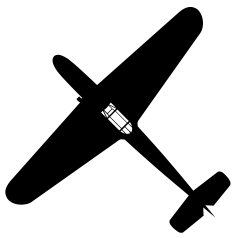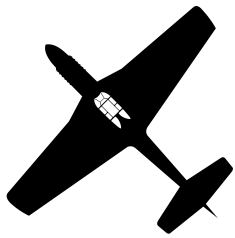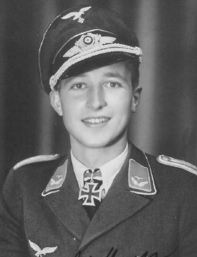The Pace of War
By Capt. Arthur F. Brown, Capt. Fredrick S. Burkhardt and 1st Lt. Rudolph A. Tholt
In addition to the excitement of participating in the great events of the war while at, Boxted, there had been other excitements, mostly concerned with the frequent night raids by the Luftwaffe. The airfield there seemed to lie directly under the path flown by the German bombers in their persistent attacks on London and there were many. There were also many nights when personnel of the group spent hours in the air raid shelters on the field. There were only a few bombs dropped in the vicinity of the field but the sound of Jerry planes and the roar of Ack-Ack defenses plus the occasional bombs dropped in Colchester or the immediate vicinity of the field, served to make these nights memorable.

From the 356th FS, "Miss Pea Ridge", was Lt. Mack Tyner's assigned P-51B Mustang. Seen here over England, displaying standard theater recognition markings applied to all USAAF fighters. It consisted of a white nose spinner and 12" wide identification bands on the cowling, top and bottom wing surfaces and horizontally across the fin and rudder.
Operationally, during the Boxted period, the group had its first mission over Berlin. On the 3rd of March the bombers attacked targets at Oranienburg, a suburb of the great Reich capitol city and, on successive missions on the 4th, 6th and 8th, the targets were in Berlin itself and, on the 9th, once more at Oranienburg. On the 21st of February Captain Stephens, of the 355th Fighter Squadron, brought home the 100th claim for enemy aircraft destroyed. Approximately, this claim was dedicated to the workers of the North American Aviation Co., Inc., who made the planes we so proudly flew. On the 10th of April the two hundredth plane was claimed destroyed. On the eighth of February our pilots were permitted, for the first time, to go down on the deck on their return from the day's mission and strafe suitable ground targets thus getting an early taste of the work they were to do so often later on. On March 25th they flew their first dive-bombing mission, attacking the marshalling yard at Creil, France. The pace of the war was rapidly accelerating and, on the 10th of April the group flew two missions on the same day for the first time, one being a dive-bombing assignment to Hasselt, Belgium and the second being an escort for medium bombers attacking Namur, Belgium. Our records made quite a to-do, on the 13th of April, over the fact that the group had flown seven missions in the past six days!
On the 17th of April, the group moved lock, stock and barrel from Boxted to what was termed an advance landing field at Lashenden, Kent about ten miles southeast of Maidstone. This move was interpreted as indicating that things were approaching a climax and that it probably would not be long before the long awaited invasion would get underway. However, the work which the group engaged in didn't change much except that there were more and more attacks against ground targets thrown into the schedule along with the long-range escorts, and the scope and tempo of operations continually stepped up. Lieutenant Colonel Charles G. Teschner joined the group as Deputy Commander, coming to us from the 363rd Fighter Group.
D-Day Operations
Toward the end of May practice alerts, special training plus secret meetings of Staff Officers behind locked doors heightened the already growing feeling that things were fast taking shape. Earlier in the month Major George J. Bravos and Captain Kenneth Fry had been assigned to the group from the Third Army Headquarters to act as Ground Liaison Officers in future operations. Enlisted men from the Transportation Sections had been sent to special schools to learn the latest methods of waterproofing vehicles. Such little things as these when added up all pointed toward an approaching climax. On the 26th of May Lt Col. Bickell received his promotion to full Colonel just one day after the group was officially placed on a six-hour alert status.
The "Pioneers" were disappointed not to be in the very first operations on D-Day, but their turn came soon when, after an inactive morning and afternoon, on the 6th they were briefed after supper for their first invasion operation, an escort cover for gliders and transports carrying paratroopers to the Chebourg Peninsula.
The final tip-off came on the third day of June when a small detail of cameramen were attached to the group and it was learned that they were there specifically to cover the group's activities in the initial phases of D-Day events. The next three days were filled with the wildest rumors in the annals of the organization so that when the news of the invasion actually arrived it was almost an anti-climax. The "Pioneers" were disappointed not to be in the very first operations on D-Day, but their turn came soon when, after an inactive morning and afternoon, on the 6th they were briefed after supper for their first invasion operation, an escort cover for gliders and transports carrying paratroopers to the Cherbourg Peninsula. It was the 96th mission for the group and take-off was just after 2100 hours on the 6th, which meant an after dark homecoming; there was another mission scheduled for the next morning with a pre-dawn take-off.
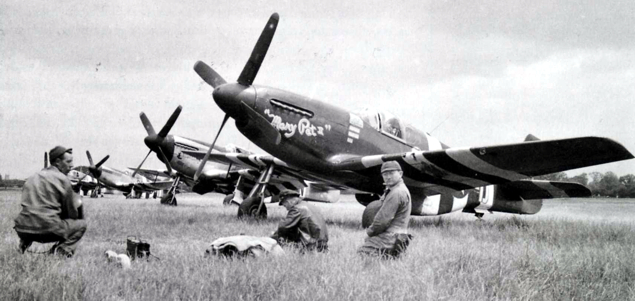
A four ship flight of P-51Bs from the 355th FS await the signal to start engines and take off from Lashenden airfield in the immediate aftermath of the D-Day landings. All allied aircraft participating in the Normandy Campaign were painted with invasion strips, alternating black and white bands for increase recognition by friendly forces.
From then on things again went along as usual for some time, the actual operations in which our planes took part being quite dull as compared with the work the group had been doing up to this time. Everyone knew that it would not be long before we would be moving into France so it was no surprise when, on the 13th, the orders were received for the advance echelon to pull out the next morning. They had been gone less than forty-eight hours when the remaining personnel were most startling introduced to the new terror of Germany's first "Secret Weapon," the V-1 or Flying Bomb.
This introduction took place at 2345 hours on the night of the 15th and the period which was inaugurated at that time was one which no one who went through it will ever forget. It lasted until the rear echelon left England on the 1st of July.
500th Destroyed
By the third of July the entire group was moved to its first continental base near Grandcamp-les-Baines on the Normandy Coast. During these first days in France the enemy was only ten miles or so away from our strip and the days and nights were filled with the sound and fury of war to an extent which our personnel never experienced before or afterwards. On the 4th of July, General Eisenhower paid a visit to the group and with Major General Quesada as pilot, flew on a short fighter sweep over the enemy-held territory around Cherbourg in the Mustang which the Group had converted into a two-seater. Other planes from the group served as escort for the generals. From invasion time on, long-range escort missions took a back seat in the operations of the 354th and the main type of mission engaged in was the fighter sweep with or without bombs. Patrols, too, especially in the Normandy days, were frequent assignments and there were all sorts of other tasks as well. The biggest single job in which the group took part while based on the beachhead was the all-out effort which paved the way for the break-through at St. Lo towards the end of July and in supporting the push which this effort made possible.
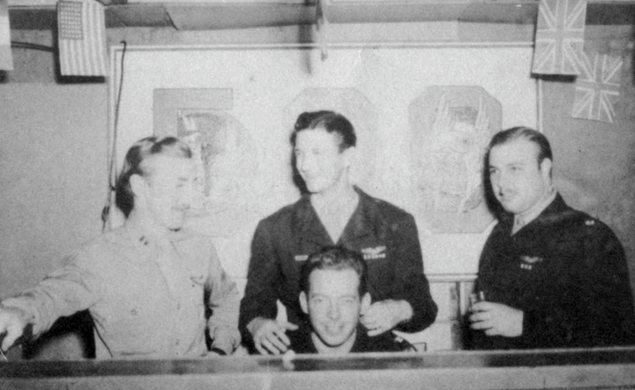
At the 500th victory party, seated is Group C.O. Col. George R. Bickell with his Squadron Leaders (left to right) Capt. Felix M. Rogers, 353rd Sqdn, Capt Richard E. Turner, 356th Sqdn and Capt. Robert W. Stephens, 355th Sqdn.
Between the 11th and 13th of August the group moved from Normandy into Brittany. At a former Luftwaffe base just north of Paimpont, the personnel spent lush days of their career on the continent. Living and recreation amongst the friendly and well stocked peasantry of Brittany, who welcomed us and treated us as their liberators, was gay and robust and, while our stay there was not overlong, everyone thoroughly enjoyed this period when the strain and work of war was so well counterbalanced by a full and pleasant social life. Food was plentiful, the calvaclos was potent, the girls were willing (even if they brought the whole family along!), the scenery was picturesque and the enemy considerate enough not to bother us with even impotent visits. Our pilots spent their days over Brest one day and over eastern France the next. Before leaving Brittany the Group had a big party celebrating the 500th enemy aircraft destroyed by our pilots. On September 9th the group flew its 500th mission since it had gone into combat on the 1st of December 1943 and, when one realizes that the 96th mission had been flown on the 6th of June, it is plain to see that the group had been extremely busy since the war came to France.
The next move was a long one and was begun on the 17th of September. Most of the personnel made the trip by plane but a few, more fortunate, went by truck or jeep. The new base was way east in the champagne country at Orconte, a little village about halfway between Vifry-le-Francois and St. Dizier. En-route to the new station most of the men got their first glimpse of Paris, either from the air or the ground and each made a mental note to get back soon for closer inspection, which almost everyone did eventually. The new base was nothing like the one in Brittany and life there was more primitive and less social than it had been further west and for a long time, there was just nothing to do which would help relieve the monotony of army life. The people here had not yet made up their minds as to how friendly they dared be with the Americans. They had no surplus food to share with their liberators and there was nothing on which to build a social program. As soon as possible control was relaxed so that the men were able to visit such interesting cities as Reims, Nancy, Troyes, and later Paris itself so that other interests and recreations could develop. Our operations continued in the relentless push of the enemy back into his own country and in decimating the strength of the wobbling Luftwaffe, and, gradually, our pilots flew more and more often over the Reich itself. This was sort of a homecoming in a way, for during June, August and September there had been very few missions which got outside of France.

